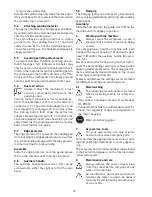
11
The specifi ed emissions values (vibration, noise)
– are used to compare machines.
– They are also used for making preliminary
estimates regarding vibration and noise loads
during operation.
– They represent the primary applications of the
power tool.
Increase possible for other applications, with oth-
er insertion tools or if not maintained adequately.
Take note of idling and downtimes of machine!
3
Power supply and start-up
The mains voltage must correspond to
the specifi cation on the rating plate.
The slide switch (1.2) serves as an On/Off switch
(I = ON, 0 = OFF).
Only RO 150 FEQ:
See Fig. 2 for connection and
disconnection of the power cable.
Always switch the machine off before con-
necting or disconnecting the mains lead!
4 Electronics
The machine has full-wave electronics
with the following features:
Smooth start-up
The smooth start-up ensures the machine starts
up jolt-free.
Speed adjustment
You can regulate the speed steplessly between
3300 and 6800 rpm using the adjusting wheel (1.4).
This enables you to optimise the cutting speed to
suit the material.
Constant speed
The pre-selected speed remains constant whether
the machine is in operation or in neutral position.
Temperature control
If the motor temperature becomes too high, the
power supply and speed are reduced. The tool
then only runs with reduced power to enable
rapid cooling by means of the motor ventilation.
After cooling down, the tool accelerates again
automatically.
5 Machine
settings
Always remove the power supply plug
from the socket before carrying out any
work on the machine.
5.1 Sanding
motion
You can use the switch (1.1) to set two different
sanding motions.
The change can only be made when the
sanding pad is stationary, as the switch
is locked in place during operation for
reasons of safety.
Rotex rotary motion (coarse sanding, polishing)
The Rotex rotary motion is a combina-
tion of rotary and eccentric motions. This
position is selected for sanding with high
output (coarse sanding) and polishing.
Slide the switch (1.1) into the right position.
Eccentric motion (fi ne sanding)
This position is selected for sanding with
low output for a scratch-free surface (fi ne
sanding).
Press the switch (1.1) downwards and push it into
the left-hand position.
5.2
Sanding pad brake
The rubber collar (3.1) prevents the sanding
pad from revving up to maximum speed in an
uncontrolled manner during eccentric motion
(fi ne sanding). Because the collar wears down
in the course of time, it has to be replaced by a
new one (order no. 465 472) as soon as there is
any reduction in the braking effect. When fi tting
a new rubber collar (3.1), make sure it is in the
correct position.
5.3
Choice and installation of the sanding
disks
Choise of sanding disk
The appliance can be fi tted with three sanding
disks of different hardness depending on the
surface to be treated.
Hard
: coarse and fi ne sanding on surfaces. Sand-
ing at edges.
Soft:
universal for coarse and fi ne sanding for fl at
and curved surfaces.
Super-soft:
fi ne sanding on formed parts, curves,
radii. Do not use on edges!
Assembly
The FastFix system enables tool-free replacement
of the sanding pad:
- Set the switch (1.1) to the right, to the Rotex
rotary motion
- Press spindle stop (1.6),
- Turn the fi tted sanding pad from the spindle
(right-handed thread)
- Keep the spindle stop pressed down and screw
on the new sanding pad up to the stop (until
it can be turned no more). Make sure that the
rubber collar (3.1) is fi tted correctly when doing
this.


























